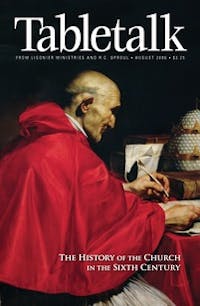
Request your free, three-month trial to Tabletalk magazine. You’ll receive the print issue monthly and gain immediate digital access to decades of archives. This trial is risk-free. No credit card required.
Try Tabletalk NowAlready receive Tabletalk magazine every month?
Verify your email address to gain unlimited access.
We Western Christians have been sending missionaries to spread the Gospel to cultures throughout the world. We sometimes forget that, unless we have a Jewish background, our cultures too were originally evangelized by missionaries. This is certainly true for those of us whose ancestors were English, Celtic, German, French, or Scandinavian, as well as other European tribes deemed “barbarian” by the Romans. Those ancient tribal societies were very much like those of Africa or the American Indians.
Tribal societies — whether European, African, or American — tend to be ruled by local “chiefs” (which the Europeans called “kings”), with a council of warriors. They tend to have religions involving the worship of nature, complex family ties, and an array of primitive customs.
If you have Irish blood, your ancestors long ago lived in huts made of animal skin, put on war paint, and collected human heads. If you have German blood, your ancestors may have made their living pillaging their neighbors and likely practiced human sacrifice.
But then the missionaries came. They bore the good tidings of Christ. Usually the first wave of missionaries to the tribes would be martyred. But the missionaries kept coming. Eventually Christianity took hold, changing not only individual believers but the whole culture.
Actually, many of these tribes came to the Christians. Rome fell to the barbarians in 476 ad. This began the “Dark Ages,” so-called because of the breakup of classical civilization, the collapse of large-scale social order, and the dominance of the barbarian tribes. The Dark Ages came to an end, though, when those barbarian tribes accepted Christianity. Then a new civilization, known as the Medieval Period, emerged.
Scholars now know the Dark Ages were not as dark as they formerly were thought to be, with much learning and cultural vitality taking place among the various European tribes. But the light in the Dark Ages usually dawned under the influence of Christianity, which curbed the tribes’ culture of violence, brought in a rule of law, and introduced education.
The end of the Dark Ages and the beginning of the Middle Ages is usually considered to be the reign of Charlemagne (742–814), who reconstituted a Holy Roman Empire and who converted the last of the major Germanic holdouts: the Saxons. This he did by defeating them in battle and forcing them to be baptized — a church growth technique that, like others, may have its theological downside, but which seems to have taken with the Saxons. That tribe of stubborn resisters to the Gospel would later give us Martin Luther and the Reformation.
Thanks to the Venerable Bede and his Ecclesiastical History of the English People, we have a detailed account of how the Gospel was brought to England. It seems back in Rome (which continued to exist even after the last emperor was deposed), a young Christian named Gregory watched a slave market. He noticed some slaves with blonde hair and blue eyes, features he, as an Italian, had not seen before. He asked someone who they were. They are Angles, he was told. Gregory replied that their name is fitting, since they look like Angels. The pun works in Latin as well as in English; that is, Anglish. The slaves had been stolen from Angle-land; that is, England.
This Gregory later become pope, Gregory the Great, which put him in a position to do something that had been on his heart ever since that day in the slave market: to send missionaries to bring the Gospel of Christ to Angle-land.
So in 596 AD, he sent a group of missionaries under a man named Augustine. Not to be confused with the great theologian from north Africa, Augustine of Hippo, he became known from his mission station as Augustine of Canterbury. He was not martyred. Rather, his message was gladly received.
Bede tells about how Augustine preached to the King of Northumbria, who then consulted with his council about whether they should accept this new religion. The chief pagan priest confessed that his gods had not done him any good. And one of the king’s men said that life seemed to him to be like a sparrow that flies through the meadhall, in one door and out the other. The bird comes out of the darkness, into a place of light — where the fire burns and the people feast — but that brief moment of pleasure is fleeting, as the bird flies back out into the darkness.
“So this life of man appears for a short space,” he concluded, “but of what went before or what is to follow we are ignorant. If, therefore, this new doctrine contains something more certain, it deserves to be followed.”
The swallow flying through the meadhall, from darkness into darkness, captures well the worldview of our own time fifteen centuries later. C. S. Lewis said that if we define the Dark Ages as the period in which classical learning has been forgotten, then we are in a new dark ages. Judging from our art, our education, our manners, and our morality, it seems indeed that we are back to barbarism.
But, as in the first Dark Ages, it will be up to Christians to keep learning and civilization alive and to bring light to those in darkness.
